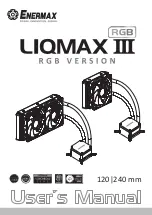
21
Appendix
Sharing Your Files and Printers
Overview
By sharing your files and printers, other PCs on your network will be able to
access the resources on your PC.
Before sharing your files and printers, you should prepare your computer to
be used with any file servers that may be on the network. If you are not using
Windows 98 or ME with an NT, 2000, or NetWare file server, or if you are
not sure if you have a file server, continue below.
Enabling File Sharing
1. Double-click your My Computer icon. A window of available disk drives
will appear.
2. Using your right mouse button, click once on the drive or folder that you
want to make available to other users.
3. Click on Sharing, followed by the Sharing tab. Click on Share As.
4. In the Share Name box, enter a name for the drive or folder you are shar-
ing. This can be any drive on your PC—floppy drive, hard drive, CD drive,
zip drive, etc.
5. Decide on the type of access that you want to give other users.
• Read-Only access allows other users to view the
files on the selected drive.
• Full access allows other users to create, change, or
delete files on the selected drive.
• Depends on Password allows other users to have
Read-Only and/or Full access to the selected drive,
depending on the password that you decide to give
them.
6. If you want to assign access passwords, type the passwords into the
Password boxes.
N
No
otte
e:: If you are only
using your PC to
access the Internet, it
is highly recommend-
ed that you create
passwords for your
shares.
Phoneline 10M Integrated PC Card
Linksys HomeLink Series
20
11. In Network Neighborhood you can only see computers running the same
operating system as your computer (i.e., your PC is running Windows 98 and
it can only see other Windows 98 computers and not any computer running
Windows 2000).
• Choose Start, Find, Computer and type the name of the computer in the
window that comes up and click Find Now.
• Now make sure that the you are using the same protocol(s) and work-
group name on the 98 and 2000 computers. To do this, click Start,
Settings, Control Panel on two computers running different Windows
operating systems. Click on the Network icon, choose the
Configuration tab, then click on the Identification tab for Workgroup
name. Compare the protocols on both computers and make sure that they
are the same. If any protocols are missing, refer to page 29 to install any
needed protocol(s).
• If all computers are using the same protocol(s) and Workgroup name, and
Windows 98 computers can't see Windows 2000 computers, enable
NetBIOS on all the computers using Windows 98 and 2000. Follow these
instructions:
• The IPX/SPX-compatible protocol should be installed on all Windows
computers (see page 29 if you need to add this protocol). Bring up the
properties of the IPX/SPX-compatible protocol by clicking on Start,
Settings, Control Panel, then double-click the Network icon. Choose
the Configuration tab and highlight IPX/SPX-compatible Protocol. Click
on Properties. Now, to install NetBIOS, click on the NetBIOS tab. Put a
check next to I want to enable NetBIOS over IPX/SPX. Click OK, then
OK again. Windows will copy the appropriate files to your computer.
When asked to restart your PC, remove any floppy disks and click OK.
Be sure to do this on all of your computers that are having trouble seeing
your entire network.






































